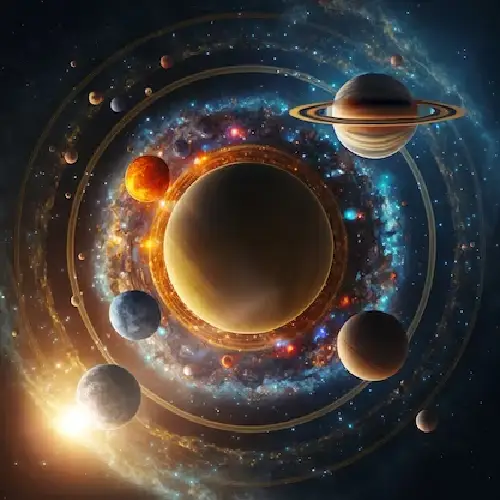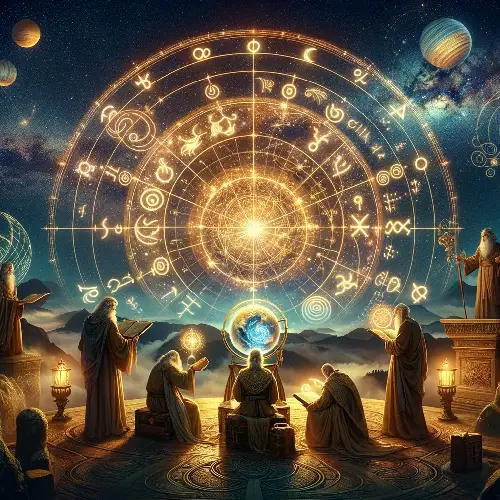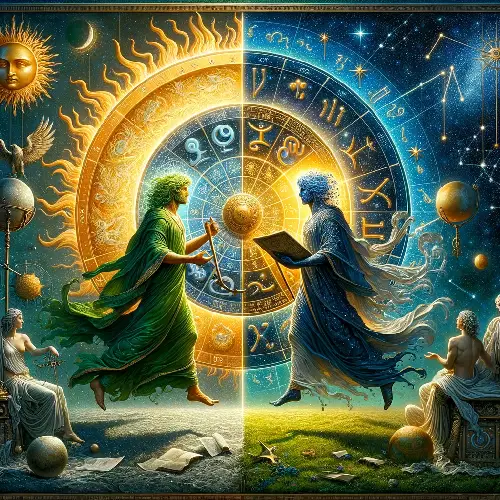In Vedic astrology, the concept of planetary aspects, known as “drishti”, is a fundamental and dynamic component that adds depth to the interpretation of a natal chart. Planetary aspects describe the relationships between different planets based on their positions in the houses and their interactions with each other. Here, we delve into the intricate tapestry of planetary aspects and their profound influences on our lives.
Understanding Planetary Aspects (Drishti)
In the celestial dance of the planets, they cast glances or aspects upon one another, influencing each other’s energies and thereby shaping the narratives of our lives. These aspects can be harmonious, fostering growth and blessings, or challenging, bringing lessons and growth opportunities.
The Types of Aspects
Conjunction (Yuti)
- Definition: When two or more planets occupy the same house.
- Influence: The energies of the planets merge, creating a powerful combined effect. The nature of the influence depends on the planets involved.
Opposition (Vipreet Drishti)
- Definition: When planets are seven houses apart (180 degrees).
- Influence: It often signifies tension and challenges, requiring balance and adjustment between the energies of the two planets involved.
Trine (Trikona Drishti)
- Definition: When planets are positioned at an angle of 120 degrees from each other, often seen between the houses 1, 5, and 9.
- Influence: Generally considered beneficial, fostering harmony and positive growth in the areas ruled by the planets involved.
Square (Kendra Drishti)
- Definition: When planets are positioned at a 90-degree angle from each other, often seen between houses 1, 4, 7, and 10.
- Influence: It represents challenges and friction, requiring effort to integrate the energies of the planets involved.
Sextile
- Definition: When planets are positioned at a 60-degree angle from each other.
- Influence: Generally considered beneficial, fostering opportunities and positive interactions between the planets involved.
Specific Planetary Aspects in Vedic Astrology
In Vedic astrology, each planet has special aspects that it casts onto other houses and planets. Here are the specific aspects for each planet:
Sun
- Aspects: The Sun primarily aspects the 7th house from its position.
- Influence: It sheds light on relationships and partnerships, often bringing clarity and focus to these areas.
Moon
- Aspects: Like the Sun, the Moon primarily aspects the 7th house from its position.
- Influence: It brings emotional depth and sensitivity to relationships and partnerships.
Mars
- Aspects: Mars aspects the 4th, 7th, and 8th houses from its position with special focus and energy.
- Influence: Mars brings energy, drive, and sometimes conflict to the areas it aspects, encouraging action and initiative.
Mercury
- Aspects: Mercury primarily aspects the 7th house from its position.
- Influence: It fosters communication and intellectual exchange in the areas it aspects.
Jupiter
- Aspects: Jupiter aspects the 5th, 7th, and 9th houses from its position with a benevolent and expansive energy.
- Influence: It brings wisdom, growth, and opportunities to the areas it aspects, fostering expansion and prosperity.
Venus
- Aspects: Venus primarily aspects the 7th house from its position.
- Influence: It brings harmony, beauty, and pleasure to the areas it aspects, fostering love and enjoyment.
Saturn
- Aspects: Saturn aspects the 3rd, 7th, and 10th houses from its position with a serious and disciplining energy.
- Influence: It brings structure, discipline, and sometimes challenges to the areas it aspects, fostering growth through hard work and perseverance.
Rahu and Ketu
- Aspects: Rahu and Ketu primarily aspect the 5th and 9th houses from their positions, creating complex and transformative influences.
- Influence: They bring transformation, upheaval, and sometimes confusion to the areas they aspect, fostering growth through change and transformation.
The Interplay of Aspects
Understanding the interplay of planetary aspects in a natal chart requires a nuanced approach. It involves analyzing the nature of the planets involved, the houses they occupy, and the signs they are in. This complex interplay shapes the individual’s personality, experiences, and life path.
Conclusion
In the grand scheme of Vedic astrology, planetary aspects play a pivotal role in shaping the intricacies of an individual’s life. They bring a dynamic and interactive dimension to the natal chart, illustrating the complex web of influences that the planets exert upon one another. Through the lens of planetary aspects, we can gain profound insights into the harmonies and tensions that play out in various spheres of our lives, guiding us towards a deeper understanding of our cosmic journey.
Understanding these planetary aspects can offer profound insights into an individual’s personality, strengths, challenges, and potential paths in life. It can be a complex, yet rewarding study, offering layers of depth and nuance to the art of astrological interpretation.


